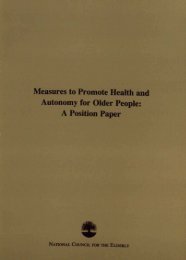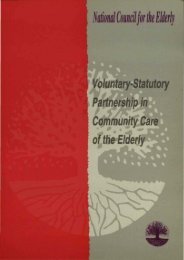From Ageism to Age Equality: Addressing the Challenges ...
From Ageism to Age Equality: Addressing the Challenges ...
From Ageism to Age Equality: Addressing the Challenges ...
You also want an ePaper? Increase the reach of your titles
YUMPU automatically turns print PDFs into web optimized ePapers that Google loves.
<strong>the</strong> use of upper age limitsa failure <strong>to</strong> take account of <strong>the</strong> situation, experiences or aspirations of older people when makingdecisions and allocating resourcesinadequate provision for <strong>the</strong> needs of older people<strong>the</strong> segregation of older people as a result of <strong>the</strong> lack of real choice <strong>to</strong> remain within <strong>the</strong>ircommunities.These sorts of institutional practices are shaped by individual attitudes and vice versa. This mix ofinstitutional practices and individual attitudes can lead <strong>to</strong> ways of relating <strong>to</strong> older people that can becharacterised by abuse, neglect, dependence and being patronised.The report has been well received by <strong>the</strong> social partners through <strong>the</strong> NESF and by a range ofGovernment Departments and State agencies. We must now move from consideration of <strong>the</strong> report<strong>to</strong> implementation of <strong>the</strong> strategy.<strong>Age</strong> DiscriminationTo put <strong>the</strong> equality strategy in<strong>to</strong> action we first need <strong>to</strong> eliminate age discrimination. The case files ofThe <strong>Equality</strong> Authority provide valuable evidence of <strong>the</strong> discrimination experienced by older peopleand <strong>the</strong>refore of <strong>the</strong> nature and size of this task. At <strong>the</strong> heart of many of <strong>the</strong>se cases is <strong>the</strong> issue ofstereotyping, that is, of holding <strong>the</strong> view that an older person’s capacity, ambition and aspirationsare defined solely in terms of <strong>the</strong>ir age. This notion is deeply embedded in our culture. It gives rise<strong>to</strong> discrimination and is a driving force for ageism.63Examples of Discrimination from <strong>the</strong> Case Files of The <strong>Equality</strong> AuthorityEmploymentIn 2003, approximately one in ten (9 per cent) of The <strong>Equality</strong> Authority’s case files under <strong>the</strong>Employment <strong>Equality</strong> Acts 1998 and 2004, which outlaw discrimination in <strong>the</strong> workplace, related <strong>to</strong><strong>the</strong> age ground. These almost exclusively involved older people. The issues covered reflect <strong>the</strong>particular difficulties faced by older people who seek <strong>to</strong> participate in <strong>the</strong> labour market. Theyincluded claims of discrimination in relation <strong>to</strong> job advertisements, interviews, promotion andworking conditions.Job advertising including age restrictions has been an ongoing focus. A successful case againstRyanair highlighted <strong>the</strong> discrimina<strong>to</strong>ry nature of a job advertisement that sought ‘a young anddynamic professional’. Ano<strong>the</strong>r case, Dunbar v. Good Counsel College, raised <strong>the</strong> issue of promotion.It found that Mr Dunbar was discriminated against because date of birth was used <strong>to</strong> determineseniority, resulting in <strong>the</strong> appointment of <strong>the</strong> older candidate, when both candidates had beenconsidered equally suitable for promotion. In ano<strong>the</strong>r case, a firm of solici<strong>to</strong>rs was found <strong>to</strong> havediscriminated against a woman who was <strong>to</strong>ld she was being made redundant because it had been‘decided <strong>to</strong> take on a young girl who could be trained <strong>to</strong> do her job’.<strong>From</strong> <strong><strong>Age</strong>ism</strong> <strong>to</strong> <strong>Age</strong> <strong>Equality</strong>: <strong>Addressing</strong> <strong>the</strong> <strong>Challenges</strong>















